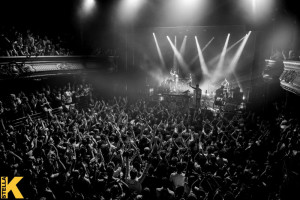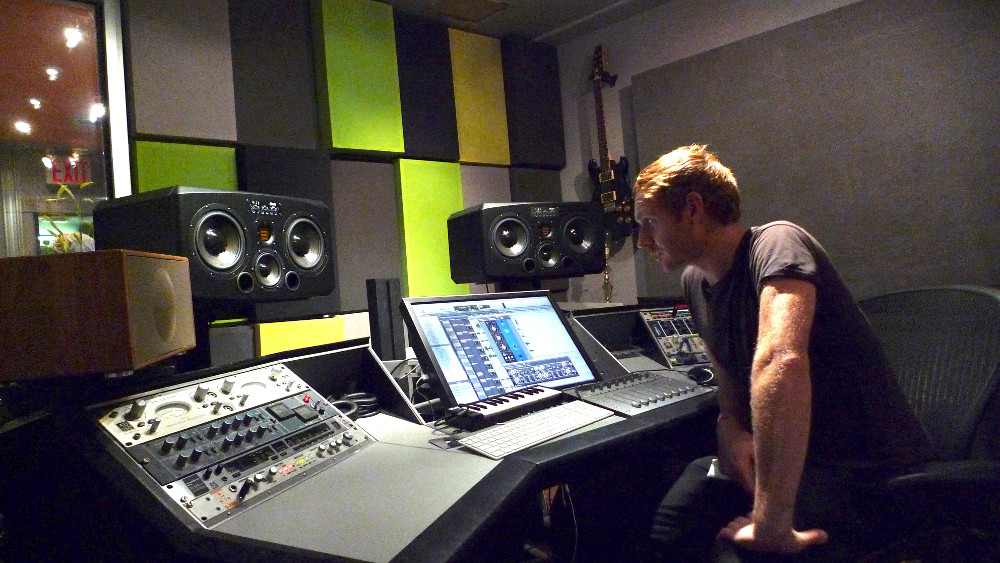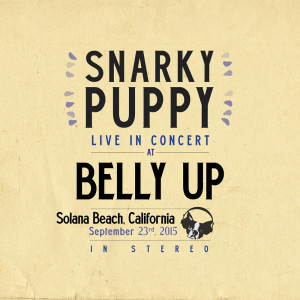Mix Analysis: How Nic Hard Mixed “Shofukan” by Snarky Puppy
Who wouldn’t want the best of both worlds?
Mixer Nic Hard certainly does, and realized he could have it via an intriguing project for Grammy Award winning instrumental fusion group Snarky Puppy. In this dreamy scenario come true, Hard gets to mix the live performances of this dynamic act – after the show, in the familiar workflow of his NYC studio.
In a forward-thinking move, Snarky Puppy’s bandleader – bassist/composer/producer Michael League – and their label decided to release the recordings of all live shows played during a fall tour. Hard knew every night would be an adventure: The band’s large and unorthodox lineup can include the likes of guitars, pianos, keyboards, woodwinds, brass, percussion and strings. Like sonic snowflakes, no two performances are ever alike.
Hard is a high-level pro (and SonicScoop contributor) whose credits include The Church, The Bravery, The Kin, Ghost Beach and many more. Insights galore include how to efficiently mix down a drumkit; the tool he relies on to control bleed; why automation really matters here; problem solving at the mastering phase; and what was the massive gamble he took in the midst of this mix project?
As Hard will point out, this isn’t something that every artist – or mixer – should attempt. But for those excited by the possibilities, let’s learn from everything this audio expert has to offer.
Mixer Name and Website: Nic Hard, nichard.com
Mix facility name, Website, and location: I have a small mix room in Flatiron, NYC set inside of Limebeat Studios.
Artist and Song: Snarky Puppy – “Shofukan” from World Tour 2015
Live to Online: At the beginning of the summer, Michael League, band leader of Snarky Puppy, called me to discuss an idea he had. He and GroundUp (Snarky Puppy’s label) wanted to release recordings of the live shows for their upcoming fall tour. The tour consisted of over 40 shows in a span of three months. Mike’s idea was different than that of many other bands (releasing FOH board mixes) — Mike wanted to have each show multi-tracked and mixed.
The label initially opposed, as this process demanded time and money, but when it was clear the end product would be of much higher quality, we came to an agreement: Snarky Puppy would send one hard drive a week throughout the course of their tour, and I would mix approximately thirty shows.
This was definitely an interesting challenge for me — just the sheer volume of the shows alone was overwhelming, not to mention that we were trying to release them as quickly as possible — we even had a couple issues with drives getting held up in customs. On top of this, I was mixing a couple other records at the time.
Compare Nic Hard’s mix of “Shofukan” (top track) with the raw FOH mixdown (bottom track). Used with permission:
Construction materials: Snarky Puppy is a nine piece instrumental group. They are largely influenced by Jazz, but are not straight ahead Jazz — they have put their own take on the genre. The band consists of a drummer, percussionist, bass player, three keyboard players, a guitarist, two trumpeters, a saxophonist, and occasionally a flute player (some of these overlap). The keyboard players have several different instruments: Rhodes, Moog, Nord Stage, Kronos, Juno, a Prophet, and sometimes a B3.
I spoke with Mike League and Matt Recchia, their live sound engineer. We decided the best course of action was to rent a board (US tour – AVID Venue SC48, EU tour Behringer X32) that was capable of being used for front of house, and capable of recording thirty-two channels over Firewire. Unfortunately, this meant that we were limited to thirty-two tracks per show. That’s pretty tight for a band this size, so we had to figure out the best way to sub-mix things. It took a couple shows to get it right (Matt and I spoke several times to exchange ideas), but once we got it, all of the following shows made so much more sense.
One of the most important things I requested was a set of audience mics. The first couple shows didn’t have these and it made a huge difference. In the studio mix, it is crucial to be able to hear the crowd clap, cheer, and yell. Having these parts available allows me to create the sensation of a live show, and keep the listener excited and engaged. It’s an added plus when the crowd decides to sing along (see 2:04 or 7:16 on the track).
Initial Pass: When I first got the shows, I had a little surprise. Show length. Most of the shows run for ninety to a hundred and twenty minutes! These were no forty-five minute sets. This in and of itself was a challenge. After the first dozen shows, I decided that I must upgrade to ProTools 12…….offline bounce.
The concept from the beginning was to have a “live” sound to these mixes. The direction I was given from Mike was pretty much just make sure everything can be heard, and keep it simple. Due to the volume of material, the costs of the project, and the aesthetic of the band, I decided that maintaining a straight forward, natural sound was the best way to go.
Mixing It! The first few shows paved the way in terms of developing a template from which the other shows could be mixed.
As with most mixes, I focus on getting the rhythm section feeling right first, and then set basic balances of the other instruments. In this instance, in keeping the “live” feel, I was doing much less experimentation than usual, and mostly sticking with basic EQ and compression.
I used a Digidesign EQ3 on the individual drum mics to do a basic cutting and filtering out the super low frequencies. The drum kit often had a “normal” snare, a very low tuned snare, and sometimes, a third snare drum. Usually, there were two kick mics, two tom mics, a pair of overheads, and a hat mic — which I didn’t need to use because there was more than enough hat coming through the overheads.
I EQ’ed and compressed each mic individually and then sent it all down to a drum bus (in series) for a bit more compression and EQ to the whole kit. A plugin that I’ve been really into using on the drum bus is the UAD Fatso Sr. There are too many good features to mention, but it really helps glue everything together. After the Fatso, I used an API 550.
One of the biggest challenges of mixing live recordings is the bleed from the other instruments and amps on stage. Sometimes it can really blur things or prevent me from EQing as bright as I’d like to. One of the most important plugins I used on the drums was the SPL Transient Designer. This awesome little box was perfect for cutting down on the amount of bleed coming through on the drum mics, which allowed me to get a cleaner, punchier sound.
On this tour, the bass was recorded direct. The bass was played on bass guitar and a Moog. The bass guitar and Moog were bussed down onto one track to stay within the 32 channel limit. As the bass was direct, I decided to virtually re-amp it using Native Instruments’ Guitar Rig.
The keyboards presented an interesting issue — they were all recorded mono. For some of the lead synth lines, this is fine, but when it came to things like the piano (Nord Stage), it was very unsatisfying. I decided to give the piano and the Juno a more stereo approach to help it feel larger and more lively. To do this, I used Digidesign’s Mod Delay (mono – stereo). I set one side to dry and the other side anywhere between 16ms and 26 ms. This can thin out the sound as certain low-mid frequencies seem to cancel, but sometimes that works to my advantage.
Usually when mixing, finding the vibe and aesthetic of the song is the number one priority, and generally the most creative part of mixing — exploring delays, distortions, etc., but since I was approaching these mixes in a more raw and natural way, the focus shifted to the balance and ambience of the song. Altiverb was a great help for this — their very real sounding halls gave a lot of size and ambience to the mix.
Focusing on automation was also key for a project like this. Snarky Puppy is a very dynamic band. They have long solo sections, quiet and beautiful piano parts, and loud driving sections. Once I set the basic levels for the show, writing the automation was extremely important — in order to ensure all the sections were heard. I have a Euphonix MC Mix which I use for doing most of my rides. I was “raised” on a Neve 8068 with flying faders, so I’ve never really enjoyed writing automation with a mouse.
One of the many advantages that a studio mix has over a FOH mix is the ability to edit out mics when they’re not being used. One of the main things I edited were the tom tracks. Sometimes the drummer would be playing a tom so softly that it was at least 10db quieter than the snare bleed during a louder section of the show. This meant that using a gate was out of the question. I had to edit these manually, but fortunately, I had the help of a very keen intern (thanks Ed Riley!).
Mixdown: After the first dozen shows, I made a risky decision — upgrade from Pro Tools 10 to 12.
Not that it was that risky, but changing systems when things are midway always feels dangerous. I was also mixing two other records! I took the risk to speed up the process. One of the major advantages Pro Tools 11 and 12 have is the offline bounce. I had some struggles at first — getting new plugins, etc., but I now have it bouncing up to 11x the rate ProTools 10 would.
For this project, I was to deliver FLAC files directly to the Website where the shows are for sale. I was given a “Content Mastering Process” PDF that detailed how I was to deliver the files. I had a quick look and realized there would be no mastering of these mixes!
I am not and will never pretend to be a mastering engineer. I think that is an entirely different set of ears, and quite honestly, I like having a last “quality control” performed by someone else. Alas, for this project, it was not to be. The budget constraints and additional time wouldn’t permit it.
Fortunately, I mix through a mix bus compressor, EQ, and limiter, so I left the limiter on (I would normally take it off when sending files to be mastered), and bounced the files.
I was to upload via FTP, 24bit 48k FLAC and 16bit 44.1 FLAC files to livedownloads.com. On the PDF I was given, there were instructions on how to convert the files from WAV to FLAC. Unfortunately the instructions were not designed for Pro Tools, and I found them more or less useless.
Another period of trial and error: The FLACs had to play seamlessly from one song to the next in a FLAC player. Chopping up the show in Pro Tools left a pop when it transitioned from one song to the next. Not cool. I found that if I bounced the whole show, and then loaded it into Audacity, I was able to label the songs and export the FLAC files in the desired bit depth and sample rates. They were labeled according to the instructions (very, very specific instructions).
I am happy to share the process with anyone facing the same thing. It was definitely a bit of a learning curve for me.
It All Adds Up: Amazingly enough, Mike League requested that he be sent every show to review before they were released. I guess that may not sound like a big deal, but I’m impressed. Not only did he have to play the show, be on the road for weeks on end, but then listen back to the show he played the week before to see if there were any mix revisions he wanted.
It was a very ambitious idea, and one I don’t think many bands could pull off. One of the reasons that it’s working for Snarky Puppy, as well as the reason I am not bored to tears, is that they are very improvisational and creative and no two sets sound the same. They have obviously worked very hard at changing up the set lists, not to mention arrangements, tempos, and solos for every show. I don’t think a pop rock band with half of their tracks sequenced, playing the same set every night would be worth recording every show on such a long tour. One would suffice.
All in all, it has been, and continues to be, a very fun project. I still have fifteen more shows to go!
— Nic Hard
Please note: When you buy products through links on this page, we may earn an affiliate commission.









